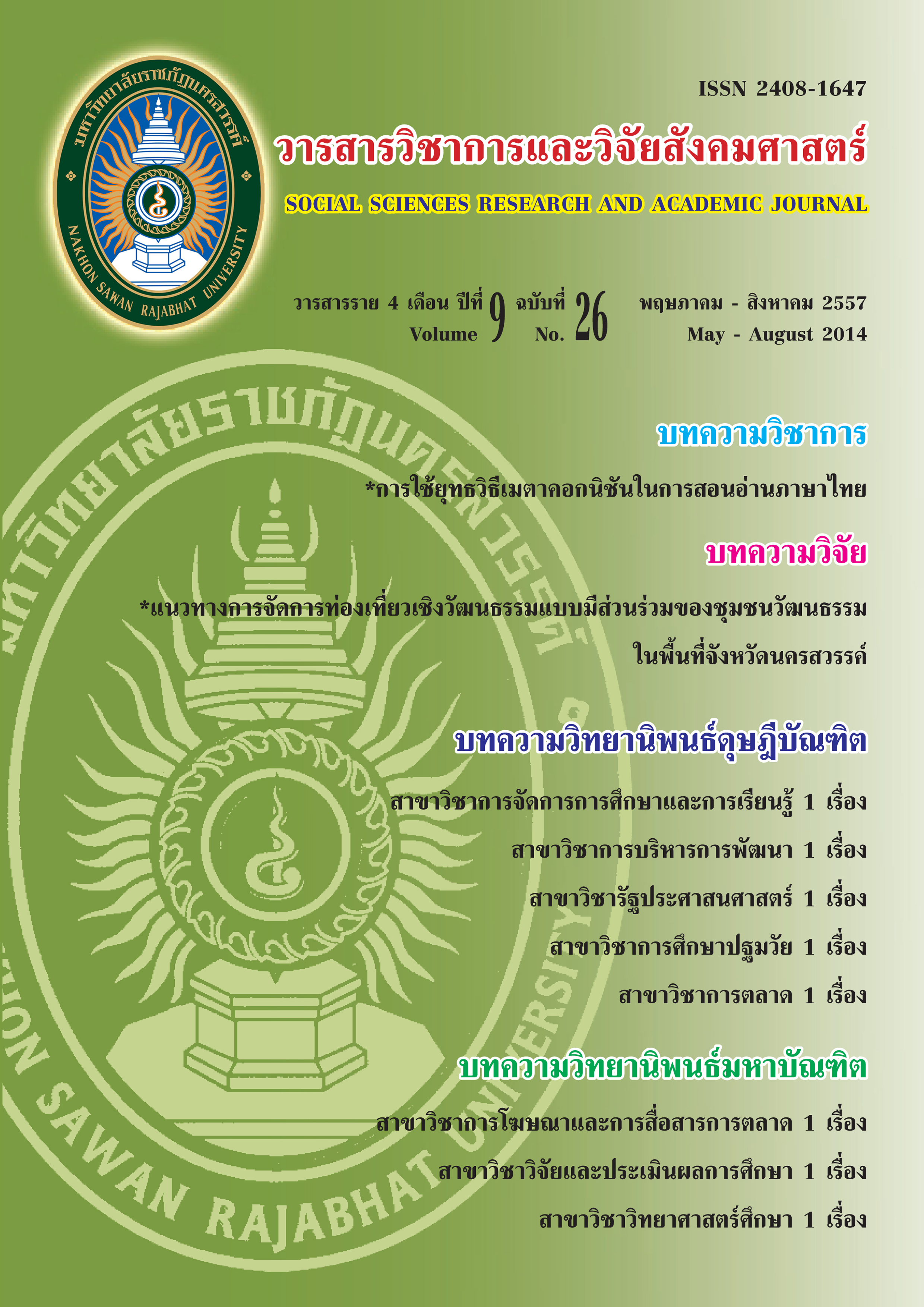รูปแบบกลยุทธ์การเน้นการตลาดเพื่อการส่งออกอาหารแช่แข็ง (The Marketing Orientation Strategy Model for Frozen Food Export)
Main Article Content
Abstract
บทคัดย่อ
การศึกษาวิจัยนี้มีวัตถุประสงค์ 1) เพื่อวิเคราะห์หาแนวทางการตลาดของผู้ประกอบการในองค์กรธุรกิจอุตสาหกรรมอาหารแช่แข็ง ในด้านการปรับกลยุทธ์การเน้นการตลาด และผลสำเร็จทางการตลาด 2) เพื่อวิเคราะห์
ตัวแปรหรือองค์ประกอบสำคัญที่มีผลกระทบกับตัวแปรแทรกต่อความสัมพันธ์เชิงสาเหตุส่งผลสำเร็จทางการตลาดขององค์กร และ 3) เพื่อนำเสนอรูปแบบความสัมพันธ์เชิงสาเหตุที่มีต่อผลสำเร็จทางการตลาดขององค์กร
ธุรกิจอุตสาหกรรมอาหารแช่แข็ง การวิจัยครั้งนี้เป็นการวิจัยเชิงปริมาณใช้เครื่องมือในการวิจัยเป็นแบบสอบถาม จำนวน
549 ชุด กับผู้ประกอบการ และการวิจัยเชิงคุณภาพใช้แบบสัมภาษณ์เชิงลึกกับหน่วยงานภาครัฐ วิเคราะห์ข้อมูล
โดยการแจกแจงความถี่ ค่าร้อยละ ค่าเฉลี่ยเลขคณิต ค่าส่วนเบี่ยงเบนมาตรฐาน และรูปแบบโมเดลสมการ
เชิงโครงสร้าง (Structure equation model: SEM)
ผลการวิจัยพบว่า แนวทางการตลาดของผู้ประกอบการในองค์กรธุรกิจอุตสาหกรรมอาหารแช่แข็ง
ในภาพรวมอยู่ในระดับมากจากกลยุทธ์การเน้นการตลาด และองค์กรธุรกิจส่วนใหญ่ไม่ดำเนินเรื่องขอความช่วยเหลือสนับสนุนจากหน่วยงานภาครัฐที่มีหน้าที่โดยตรง จึงทำให้การสนับสนุนจากส่วนอื่นๆ ได้รับผลกระทบและผลเป็นลบตามมา ดังนั้นผู้ประกอบการควรขอรับการสนับสนุนจากหน่วยงานภาครัฐที่มีความเกี่ยวข้องโดยตรง โดยเฉพาะการสนับสนุนปัจจัยต่างๆ ที่เอื้ออำนวยต่อการประกอบธุรกิจส่งออกอาหารแช่แข็งให้ประสบผลสำเร็จและสามารถแข่งขันกับตลาดเพื่อนบ้านได้ โดยผลการนำเสนอรูปแบบความสัมพันธ์
เชิงสาเหตุที่มีต่อผลสำเร็จทางการตลาดขององค์กรธุรกิจอุตสาหกรรมอาหารแช่แข็ง สามารถเขียนในรูปแบบโมเดล
สมการเชิงโครงสร้างดังต่อไปนี้
ผลสำเร็จทางการตลาด = (-0.453 การเน้นกลุ่มเป้าหมายในปัจจุบัน) + (0.421* การเน้นกลุ่มเป้าหมายในอนาคต) + (-0.766 การสนับสนุนของภาครัฐ) + (-0.481 การเน้นด้านเทคโนโลยี) + (-0.261 การเน้นที่ความเข้าใจถึงอุปสรรคและความเสี่ยง) + (0.410* การเน้นที่การปรับตัวของผู้ประกอบการ) + (0.510* การเน้นการพัฒนาผลิตภัณฑ์ใหม่) + (0.800* ขนาดองค์กร)
Abstract
The purposes of this research were to 1) analyse marketing approach of the entrepreneur in the frozen food industry in the adjusting marketing orientation strategy and the marketing performance. 2) To analyse the variables or main factors that affect the intervening variable and the causal relationship of the marketing performance and 3) to present a causal relationship model for affecting the marketing performance of the frozen food industry. The research methodology was a quantitative research using questionnaires completed by 549 entrepreneurs and a quality research using in-depth interview with government executive agencies. Data was analysed by frequency, percentage, arithmetic mean, standard deviation and Structural Equation Model (Structure equation model: SEM).
The findings showed that marketing approach of the entrepreneur in the frozen food industry coming in overall at a high level in the marketing orientation strategy and most businesses did not proceed with the assistance from the government agencies that have full responsibility for exporting. Thus, others who were supporting this program have been affected and have had negative results. Entrepreneurs should seek the support of government agencies that are directly relevant, in particular supporting the many factors that favor businesses to export frozen food successfully to the neighboring markets. The result of the presenting of
a causal relationship model for affecting the marketing performance of the frozen food industry can also be written in the Structural Equation Model: SEM from the following.
Marketing Performance = -(0.453 Focus Current Target) + (0.421* Focus Future target) + (-0.766 Government Support) + (-0.481 Technology Orientations) + (-0.261 Focus on Barriers and Risks) + (0.410* Focus on the Adaptation of Entrepreneurs) + (0.510* Focus on New Product development) + (0.800* Firm Size).


